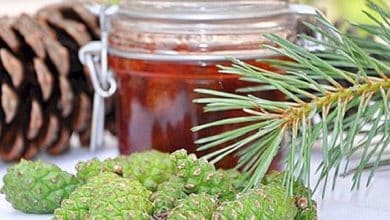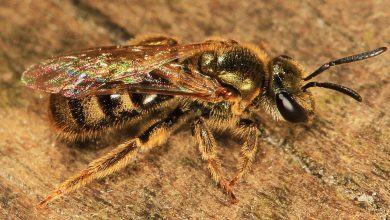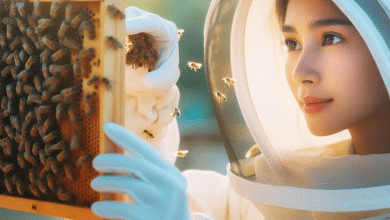
Manuka Honey has become a sensation in recent years, capturing the attention of health enthusiasts and honey lovers alike. Originating from New Zealand, this unique honey has gained a reputation for its exceptional healing properties and numerous health benefits. But what makes Manuka Honey so special, and what sets it apart from other types of honey? The answer lies in the bees behind this remarkable honey.
Manuka Honey is produced by a specific type of bee known as the Manuka bee. These bees are unique because they only visit the Manuka tree (Leptospermum scoparium) to collect nectar. The Manuka tree, native to New Zealand and parts of Australia, produces a rich and potent nectar that is then transformed into this extraordinary honey by the diligent Manuka bees.
The Manuka bees play a vital role in the honey-making process. They collect nectar from the Manuka tree, which contains natural compounds that give Manuka Honey its distinct flavor and health-promoting properties. The bees then transform this nectar into honey using their enzymes and natural fermentation processes, creating a honey that is unlike any other.
The rise in popularity of Manuka Honey can be attributed to its numerous health benefits, particularly its potent antibacterial properties and ability to support wound healing. These unique properties have made Manuka Honey a sought-after natural remedy for various ailments and a popular ingredient in skincare products.
In this article, we will explore the fascinating world of Manuka bees and delve into the intricate process of Manuka Honey production. We will also discuss the impressive health benefits of Manuka Honey and provide insights on how to choose the right Manuka Honey for your needs. So, join us as we uncover the buzz about Manuka Honey and discover the wonders of these exceptional bees.
The Rise in Popularity of Manuka Honey
Manuka Honey has experienced a meteoric rise in popularity over the past few years, captivating the attention of health enthusiasts and honey lovers alike. This unique honey from New Zealand has garnered a significant following, and its reputation as a superfood and natural remedy continues to grow.
One of the key factors contributing to the increasing popularity of Manuka Honey is its exceptional healing properties. Unlike regular honey, Manuka Honey possesses potent antibacterial qualities, thanks to its high content of natural compounds such as methylglyoxal (MGO). This makes it highly effective in combating bacteria and promoting overall immune health.
Another reason for the surge in demand for Manuka Honey is its ability to support wound healing. Studies have shown that Manuka Honey can accelerate the healing process of various wounds, including burns, ulcers, and surgical incisions. Its unique ability to stimulate tissue regeneration and reduce inflammation has made it a go-to remedy for many individuals seeking natural alternatives for wound care.
Furthermore, Manuka Honey’s popularity can be attributed to its versatility. It can be used not only as a dietary supplement but also as an ingredient in skincare products, such as face masks and balms. The antimicrobial and moisturizing properties of Manuka Honey make it an ideal choice for promoting healthy and glowing skin.
As more people become aware of the distinctive benefits offered by Manuka Honey, its demand continues to soar. However, it is important to note that not all Manuka Honey is created equal. The quality and potency of Manuka Honey can vary depending on factors such as the region it is sourced from and its Unique Manuka Factor (UMF) rating. It is crucial for consumers to choose reputable brands that provide accurate labelling and transparent information about their honey.
In conclusion, the rise in popularity of Manuka Honey can be attributed to its exceptional healing properties, versatility, and growing awareness of its unique qualities. As more people discover the wonders of this extraordinary honey, it has become a must-have product for those seeking natural remedies and holistic health solutions.
Why Manuka Honey is Unique
Manuka Honey stands apart from other types of honey due to its unique and exceptional qualities. This honey is derived from the nectar of the Manuka tree, which is native to New Zealand. What sets Manuka Honey apart is its high concentration of natural compounds, particularly methylglyoxal (MGO), which gives it its potent antibacterial properties. No other honey in the world contains such high levels of MGO as Manuka Honey does.
The antibacterial properties of Manuka Honey make it highly effective in combating harmful bacteria and promoting overall immune health. It has been used for centuries as a natural remedy for various ailments, including sore throats, digestive issues, and wound healing.
Another characteristic that makes Manuka Honey unique is its ability to support wound healing. It has been found to stimulate tissue regeneration, reduce inflammation, and promote the formation of new blood vessels, making it an ideal choice for treating cuts, burns, ulcers, and surgical incisions.
In addition to its medicinal properties, Manuka Honey is also valued for its versatility. It can be consumed as a dietary supplement, used as a natural sweetener, or incorporated into various skincare products. Its antimicrobial and moisturizing properties make it beneficial for promoting healthy skin and treating conditions such as acne and eczema.
It is important to note that not all Manuka Honey is created equal. The quality and potency of Manuka Honey can vary, depending on factors such as the region it is sourced from and its Unique Manuka Factor (UMF) rating. It is recommended to choose a reputable brand that provides accurate labeling and transparent information about their honey.
In conclusion, the unique properties of Manuka Honey, such as its high levels of MGO and exceptional healing capabilities, set it apart from other types of honey. Its versatility and natural antibacterial properties make it a valuable addition to anyone’s health and wellness routine.

Contents
Understanding Manuka Bees
Manuka bees, also known as Apis mellifera, are a unique species of honey bees that play a vital role in the production of Manuka honey. These bees are native to New Zealand and thrive in the rugged landscapes where Manuka trees grow.
What sets Manuka bees apart is their ability to collect nectar from the Manuka flowers. The nectar, which contains the essential compounds that give Manuka honey its exceptional properties, is carefully harvested by the bees. Manuka bees have a specialized proboscis that allows them to extract the nectar from the flowers’ intricate structures.
Manuka bees are highly efficient and hardworking. They have a strong sense of smell and can navigate through the dense forests to find the best sources of nectar. These bees also have a longer lifespan compared to other honey bee species, allowing them to contribute more to honey production.
The symbiotic relationship between Manuka bees and Manuka trees is crucial for the survival and reproductive success of both species. The bees rely on the nectar from the Manuka flowers for their food supply, while the trees depend on the bees for pollination. Through this mutualistic partnership, both the bees and the trees thrive.
It is fascinating to observe the intricate dance between Manuka bees and Manuka trees, as they work together to create one of the most sought-after honeys in the world. The specialized traits and behaviors of Manuka bees contribute to the unique and exceptional qualities of Manuka honey, making it a precious and valuable resource. By understanding the importance of Manuka bees, we can truly appreciate the remarkable journey that leads to the production of this special honey.
The Specialty of Manuka Bees
Manuka bees are a remarkable species known for their unique abilities and specialized traits. These bees have adapted to thrive in the rugged landscapes where Manuka trees grow, making them an essential component of Manuka honey production.
One of the specialties of Manuka bees lies in their ability to collect nectar from the Manuka flowers. The nectar contains essential compounds that give Manuka honey its exceptional properties, such as high levels of methylglyoxal (MGO). These bees have a specialized proboscis, a long, slender feeding tube, which allows them to extract the nectar from the intricate structures of the Manuka flowers. This specialized feeding mechanism sets them apart from other bee species.
Manuka bees are highly efficient and hardworking creatures. They have a strong sense of smell and excellent navigational skills, enabling them to locate the best sources of nectar in the dense forests where Manuka trees grow. These bees also have a longer lifespan compared to other honey bee species, allowing them to contribute more to honey production.
Moreover, Manuka bees play a crucial role in the symbiotic relationship between Manuka trees and themselves. The bees depend on the nectar from the Manuka flowers as their food supply, while the trees rely on the bees for pollination. This mutualistic partnership ensures the survival and reproductive success of both species.
The specialty of Manuka bees lies in their remarkable abilities to collect nectar from Manuka flowers, their hardworking nature, and their vital role in the survival of Manuka trees. Without these bees, the production of Manuka honey would not be possible. Understanding and appreciating the exceptional capabilities of Manuka bees allows us to fully comprehend the remarkable journey that leads to the production of this special honey.
The Role of Manuka Bees in Honey Production
Manuka bees play a vital role in the production of Manuka honey. These industrious insects are primarily responsible for the collection and transport of nectar from the Manuka flowers to the beehive. This process is essential for the creation of honey.
Manuka bees excel at locating and extracting nectar from the intricate structures of the Manuka flowers. Their specialized proboscis allows them to access the nectar and store it in a special pouch located in their abdomen known as the honey sac. The bees then return to the beehive where the nectar is regurgitated and processed by other worker bees.
Once the nectar is back in the hive, worker bees begin to convert it into honey. Through a process of evaporation and enzyme activity, the nectar’s liquid content is reduced, and sugars are broken down to create the final product, honey. The bees fan their wings to promote the evaporation process, ultimately resulting in the creation of thick, viscous honey.
During this process, Manuka bees also add enzymes that enhance the honey’s flavor, aroma, and antibacterial properties. These enzymes contribute to Manuka honey‘s unique characteristics, making it a sought-after and valued product.
In addition to honey production, Manuka bees also have a crucial role in maintaining the health and sustainability of the Manuka tree population. Through their pollination efforts, the bees ensure the reproduction and growth of the Manuka trees, allowing for a continuous supply of nectar for honey production.
Overall, the role of Manuka bees in honey production is indispensable. Their specialized abilities and hard work contribute to the creation of high-quality Manuka honey while also supporting the ecosystem and ensuring the survival of the Manuka tree species.
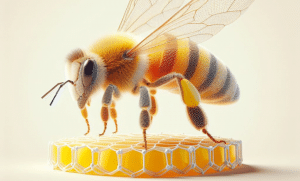
The Manuka Honey Production Process
The production of Manuka honey involves a meticulous process that starts with the pollination efforts of Manuka bees. These bees play a crucial role in the reproduction and growth of Manuka trees by transferring pollen from the male flowers to the female flowers, ensuring the production of nectar-rich blossoms.
Once the Manuka bees have collected the nectar from the Manuka flowers, they return to the beehive. The nectar is then regurgitated and processed by the worker bees. During this process, enzymes are added to the nectar to enhance the honey’s flavor, aroma, and antibacterial properties.
The next step in the production process is the evaporation of excess water from the nectar. Worker bees fan their wings vigorously, causing water to evaporate and thicken the nectar into honey. This evaporation process is crucial for achieving the desired consistency and quality of Manuka honey.
Once the honey has reached the desired thickness, it is sealed in honeycombs within the beehive. The bees cap the honeycomb cells with beeswax to preserve the honey’s freshness and protect it from external contaminants.
To harvest the honey, beekeepers carefully remove the honeycombs from the beehive. The honeycombs are then extracted using specialized equipment, such as honey extractors or centrifugal force. This extraction process separates the honey from the honeycomb.
Finally, the harvested honey undergoes a filtration process to remove any impurities. This ensures that the Manuka honey is pure and of high quality.
The Manuka honey production process is a fascinating and intricate journey that highlights the hard work and dedication of both the Manuka bees and beekeepers. The result is a unique and highly valued honey known for its distinct flavor, therapeutic properties, and worldwide popularity.
Pollination by Manuka Bees
Pollination is a vital process in the growth and reproduction of plants, and Manuka bees play a crucial role in the pollination of Manuka trees. These bees are specifically attracted to the nectar-rich blossoms of the Manuka flowers, making them uniquely suited for the pollination of this particular species.
As the Manuka bees feed on the nectar, they inadvertently collect tiny pollen grains on their bodies. When the bees move from flower to flower, they transfer the pollen from the male flowers to the female flowers, facilitating fertilization and fruit production. This transfer of pollen is essential for the formation of seeds and the development of new Manuka plants.
The pollination efforts of Manuka bees are not only beneficial for the growth and survival of Manuka trees but also for the overall health of the ecosystem. These bees contribute to the biodiversity of their environment by supporting the reproduction of various plant species.
It is worth noting that Manuka bees have co-evolved with Manuka trees over centuries, resulting in a specialized relationship between the two. The bees have developed specific adaptations that allow them to efficiently collect and transfer pollen, ensuring the continued survival of both the bees and the trees.
The pollination process by Manuka bees is a natural and essential part of the Manuka honey production cycle. Without their efforts, the nectar-rich blossoms would not develop, and the bees would not have a source of food. This intricate relationship between the bees and the trees highlights the delicate balance of nature and the interdependence of species within an ecosystem.
Harvesting and Extraction of Manuka Honey
Harvesting and extraction of Manuka honey is a delicate process that requires precision and care to maintain the honey’s quality and unique properties. The harvesting season for Manuka honey typically occurs during the summer months when the Manuka trees are in full bloom and the bees have collected sufficient nectar.
During the harvesting process, beekeepers carefully collect the honeycomb frames from the beehives. These frames are then transported to a processing facility, where the extraction process begins.
To extract the honey, the frames are first uncapped using a heated knife or a machine that removes the beeswax caps from each individual honeycomb cell. This allows the honey to flow freely.
Next, the frames are placed in a honey extractor, a centrifugal machine that uses force to spin the frames and extract the honey from the comb. The honey is then collected and filtered to remove any impurities or debris.
Once the extraction process is complete, the honey is typically stored in stainless steel tanks to prevent contamination and maintain its freshness. It is important to note that Manuka honey can be prone to granulation due to its high sugar content, so proper storage and controlled temperatures are essential to preserve its smooth texture.
After the honey has been extracted and stored, it undergoes laboratory testing to determine its unique qualities, including its UMF (Unique Manuka Factor) rating. This rating system measures the honey’s antibacterial potency and quality, ensuring that consumers are getting genuine Manuka honey.
The harvesting and extraction process of Manuka honey is a labor-intensive endeavor that requires the expertise of beekeepers to ensure the honey’s purity and potency. The careful handling and processing of Manuka honey contribute to its reputation as one of the world’s most prized and sought-after honeys.

Health Benefits of Manuka Honey
Manuka honey is renowned for its numerous health benefits, making it a popular choice for those looking to enhance their well-being. Its unique properties set it apart from regular honey, offering a range of advantages that have been supported by scientific research.
One of the key benefits of Manuka honey is its potent antibacterial properties. It contains a compound called methylglyoxal (MGO), which has been shown to inhibit the growth of harmful bacteria. This makes it effective in treating wounds, soothing sore throats, and promoting oral health by preventing the growth of bacteria that can cause gum disease and tooth decay.
Furthermore, Manuka honey has been found to have antioxidant properties, helping to reduce oxidative stress and protect cells from damage caused by free radicals. This can contribute to overall health and may have anti-aging effects.
Manuka honey is also known for its ability to aid in digestion. It can help soothe the digestive system, relieve symptoms of acid reflux and gastritis, and improve overall gut health. Its prebiotic properties support the growth of beneficial bacteria in the gut, promoting a healthy digestive system.
Moreover, this special honey has been found to have anti-inflammatory effects, which can help alleviate symptoms of inflammatory conditions, such as arthritis and inflammatory bowel disease.
In addition to these health benefits, Manuka honey has also been used to support wound healing, enhance immune function, and improve skin health when used topically.
When choosing Manuka honey, it is important to consider the Unique Manuka Factor (UMF) rating, as it indicates the potency and quality of the honey’s antibacterial activity. Higher UMF ratings correspond to higher levels of beneficial compounds.
Incorporating Manuka honey into your daily routine can be as simple as adding it to your tea, spreading it on toast, or using it as a natural sweetener in recipes. Its unique and powerful health benefits make it a valuable addition to any wellness regimen.
Antibacterial Properties of Manuka Honey
Manuka honey is widely known for its powerful antibacterial properties, making it a popular natural remedy for various health issues. The secret lies in its unique composition and the presence of a compound called methylglyoxal (MGO), which gives Manuka honey its antibacterial potency.
Numerous studies have demonstrated the effectiveness of Manuka honey in inhibiting the growth and activity of harmful bacteria. It has been found to be particularly effective against antibiotic-resistant strains, such as MRSA (methicillin-resistant Staphylococcus aureus), which have become a major concern in healthcare settings.
The antibacterial properties of Manuka honey are attributed to the high levels of MGO it contains. MGO has been shown to disrupt the bacterial cell membrane, leading to cell death. It also inhibits the formation of biofilms, which are colonies of bacteria that adhere to surfaces and contribute to the persistence of infections.
In addition to its direct antibacterial effects, Manuka honey also stimulates the immune system. It activates macrophages, a type of immune cell, to release substances that enhance tissue healing and reduce infection. This dual action of killing bacteria and boosting immune response makes Manuka honey a potent and versatile antibacterial agent.
Furthermore, Manuka honey has been found to have a broad spectrum of antibacterial activity, targeting both Gram-positive and Gram-negative bacteria. This means it can be effective against a wide range of bacteria, including those that cause common infections like sore throats, wound infections, and urinary tract infections.
The unique antibacterial properties of Manuka honey have made it a valuable natural remedy for various conditions. From minor cuts and scrapes to serious infections, Manuka honey can help prevent and treat bacterial growth, providing a safe and effective alternative to conventional antibiotics.
The Healing Properties of Manuka Honey
Manuka honey is not only known for its antibacterial properties but also for its remarkable healing properties. The unique composition of Manuka honey gives it the ability to promote wound healing and soothe various skin conditions.
One of the key factors that contribute to the healing properties of Manuka honey is its high sugar content. The high sugar concentration creates an osmotic effect, drawing moisture from the surrounding tissues and creating a moist environment that enhances the healing process. This helps to expedite the regeneration of new tissues and minimize scarring.
Manuka honey also contains enzymes, such as glucose oxidase, which produces hydrogen peroxide when it comes into contact with body fluids. Hydrogen peroxide has strong antimicrobial properties and helps to prevent infection in wounds and cuts. Additionally, Manuka honey has been found to have anti-inflammatory effects, reducing swelling and inflammation associated with injuries and skin conditions.
Moreover, Manuka honey has been used for centuries to treat burns and ulcers. Its ability to create a protective barrier over the skin helps to shield it from external irritants and promote healing. The honey’s natural pH balance also contributes to its healing properties by creating an optimal environment for cell growth and repair.
Furthermore, research has shown that Manuka honey can stimulate the production of collagen, a protein that plays a crucial role in wound healing. Collagen helps to strengthen the structure of the skin and promotes the formation of new blood vessels, which aids in the delivery of nutrients and oxygen to the healing area.
In conclusion, the healing properties of Manuka honey are truly remarkable. Its ability to promote wound healing, reduce inflammation, and protect the skin make it a popular natural remedy for various skin conditions and injuries. Incorporating Manuka honey into your skincare routine or using it as a topical treatment can help harness its healing potential and enhance your overall well-being.
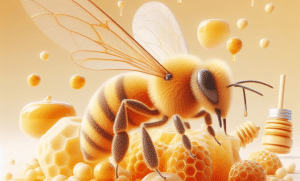
Choosing the Right Manuka Honey
When it comes to choosing the right Manuka honey, there are a few key factors to consider. With so many brands and options available, it can be overwhelming to decide which one is the best for you. Here are some tips to help you make an informed choice:
- Understanding the UMF Rating System: The UMF (Unique Manuka Factor) rating is a measure of the honey’s antibacterial strength and purity. Look for honey with a UMF rating of 10 or higher to ensure high quality and therapeutic benefits.
- Check for Authenticity: Look for the UMF trademark and license number on the packaging to ensure that the honey is genuine. This guarantees that it has been independently tested and meets the strict standards set by the UMF Honey Association.
- Consider the MGO Content: MGO (Methylglyoxal) is a compound found in Manuka honey that is responsible for its antibacterial properties. The higher the MGO content, the stronger the antibacterial activity. Look for a honey with a minimum MGO content of 100 for effective healing potential.
- Determine the Source: Manuka honey can come from different regions in New Zealand, each with its own unique environmental conditions. Some regions, such as the East Cape, produce honey with higher levels of beneficial compounds. Research the source of the honey to ensure it comes from a reputable and sustainable producer.
- Taste and Texture: Manuka honey can vary in taste and texture. Some may have a stronger and more distinct flavor, while others may be milder. Consider your personal preference when choosing a honey that suits your taste buds.
By considering these factors, you can make an informed decision and choose the right Manuka honey that best suits your needs. Whether you are looking for its antibacterial properties or its healing benefits, selecting a high-quality honey ensures that you are getting the most out of this exceptional natural remedy.
Understanding the UMF Rating System
Understanding the UMF Rating System: Manuka honey is renowned for its unique antibacterial and healing properties. To ensure the authenticity and quality of Manuka honey, it is important to understand the UMF rating system. UMF stands for Unique Manuka Factor and is a measure of the honey’s antibacterial strength and purity.
The UMF rating ranges from 0 to 30+, with a higher rating indicating stronger antibacterial activity. The rating is determined through laboratory testing that evaluates the presence of specific compounds, such as methylglyoxal (MGO), dihydroxyacetone (DHA), and leptosperin. These compounds are naturally occurring in Manuka honey and contribute to its exceptional health benefits.
The UMF rating also confirms that the honey is genuine and meets the strict standards set by the UMF Honey Association. To ensure authenticity, look for the UMF trademark and license number on the packaging.
When choosing Manuka honey, it is recommended to select a honey with a UMF rating of 10 or higher. This ensures a higher concentration of beneficial compounds and greater therapeutic potential. However, it’s important to note that lower UMF ratings can still offer some health benefits.
It is also worth noting that the UMF rating is not the same as the MGO content. MGO is a compound found in Manuka honey that is responsible for its antibacterial activity. While a higher UMF rating generally corresponds to a higher MGO content, it is possible for a honey with a lower UMF rating to have a higher MGO content.
In conclusion, understanding the UMF rating system is essential when choosing the right Manuka honey. By selecting a honey with a UMF rating of 10 or higher, you can ensure that you are getting a high-quality honey with potent antibacterial properties and therapeutic benefits.
Factors to Consider When Buying Manuka Honey
When buying Manuka honey, there are several factors to consider to ensure that you are getting a genuine and high-quality product. Here are some key factors to keep in mind:
- UMF Rating: The UMF rating system is a measure of the honey’s antibacterial strength and purity. Look for a UMF rating of 10 or higher to ensure a higher concentration of beneficial compounds and greater therapeutic potential. The UMF trademark and license number on the packaging confirm its authenticity.
- MGO Content: MGO is a compound found in Manuka honey that is responsible for its antibacterial activity. While a higher UMF rating generally corresponds to a higher MGO content, it is essential to check the specific MGO level to understand the honey’s potency.
- Source and Region: The Manuka honey should come from reputable beekeepers who follow sustainable and ethical practices. Additionally, Manuka honey from New Zealand is highly regarded due to the stringent regulations and testing procedures in place.
- Quality Standards and Testing: Look for honey that meets the standards set by the UMF Honey Association or other reliable certification bodies. Third-party lab testing ensures the authenticity and quality of the honey.
- Packaging and Labeling: The packaging should clearly display the UMF trademark and license number, along with the UMF rating and MGO content. Avoid products with vague or misleading labels.
- Price: Genuine Manuka honey undergoes rigorous testing and production processes, making it more expensive than regular honey. Be cautious of significantly cheaper options, as they may be adulterated or of lower quality.
By considering these factors, you can confidently choose a high-quality Manuka honey that offers the unique antibacterial and healing properties for which Manuka honey is renowned. Incorporate it into your daily routine and enjoy its numerous health benefits.
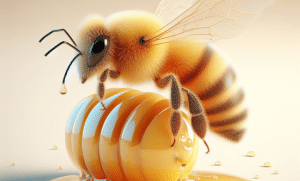
Conclusion Manuka honey
In conclusion, Manuka honey is a truly exceptional honey that offers a wide range of benefits. Its unique properties make it highly sought after and widely regarded for its healing and antibacterial properties. The symbiotic relationship between the Manuka bees and the Manuka trees plays a crucial role in the production of this extraordinary honey.
Manuka honey’s antibacterial properties make it an effective natural remedy for various health issues, including sore throat, wounds, and digestive problems. Its healing properties have been recognized and utilized for centuries, making it a staple in traditional medicine practices.
Choosing the right Manuka honey is essential to ensure its authenticity and quality. The UMF rating system serves as a guide for consumers to determine the concentration of beneficial compounds in the honey. Factors such as the MGO content, source and region, quality standards, and packaging should also be considered when purchasing Manuka honey.
Incorporating Manuka honey into your daily routine can be done in various ways. It can be used as a sweetener in tea or coffee, added to smoothies or yogurt, or used as a natural ingredient in homemade skincare products.
Overall, Manuka honey offers a versatile and beneficial addition to your pantry and skincare routine. Its unique properties and rich history make it a truly remarkable honey that continues to captivate the world. So, next time you reach for honey, consider the buzz surrounding Manuka honey and experience its exceptional qualities for yourself.
The Versatility of Manuka Honey
Manuka honey‘s versatility extends far beyond its delicious taste and numerous health benefits. It can be incorporated into a variety of daily routines to enhance both wellness and beauty regimens. With its unique properties, Manuka honey offers a range of uses that make it an essential addition to any pantry or skincare routine.
First and foremost, Manuka honey can be used as a natural sweetener. Whether stirred into a cup of tea or drizzled over a bowl of yogurt, its distinct flavor adds a touch of sweetness to any dish. Not only does it enhance the taste, but it also provides the added benefit of its antibacterial properties.
In addition to its culinary uses, Manuka honey is also a popular ingredient in homemade skincare products. Its moisturizing and nourishing qualities make it an excellent choice for face masks, body scrubs, and lip balms. Applying Manuka honey topically can help improve skin hydration, reduce inflammation, and promote a healthy complexion.
Furthermore, Manuka honey can be utilized as a natural remedy for various health issues. Its antibacterial properties make it effective in soothing sore throats and relieving coughs. It can also be used as a natural wound healer and has been known to assist in the healing process of cuts, burns, and ulcers.
The versatility of Manuka honey makes it a valuable staple for both wellness enthusiasts and beauty gurus alike. Its unique qualities make it a go-to ingredient for those seeking natural and effective remedies. So whether you choose to incorporate it into your meals, skincare routine, or medicinal practices, Manuka honey is sure to deliver its exceptional benefits.
How to Incorporate Manuka Honey into Your Daily Routine
Incorporating Manuka honey into your daily routine is easier than you might think. With its unique properties and delicious taste, this special honey can enhance both your wellness and beauty regimens. Here are some simple ways to make Manuka honey a part of your everyday life:
- Start your day with a spoonful of Manuka honey. Add a teaspoon to your morning tea or drizzle it over your cereal or yogurt for a naturally sweet and nutritious boost.
- Use Manuka honey in your cooking and baking. It can be a great substitute for sugar in recipes, adding a touch of sweetness and health benefits to your favorite dishes.
- Create a DIY face mask or scrub with Manuka honey. Its moisturizing and antibacterial properties make it an excellent ingredient for rejuvenating your skin. Mix it with other natural ingredients like yogurt or oatmeal for a soothing and nourishing treatment.
- Enjoy a Manuka honey-infused beverage. Mix it with warm water and lemon for a refreshing and immune-boosting drink, or add it to your smoothies for an extra health kick.
- Use Manuka honey as a natural remedy. Its antibacterial properties can help soothe sore throats and relieve coughs. Dilute it in warm water or tea and drink it to ease discomfort.
Remember to look for a high-quality Manuka honey with a UMF (Unique Manuka Factor) rating for maximum benefits. Incorporating Manuka honey into your daily routine is a simple and enjoyable way to enhance your overall well-being and take advantage of its exceptional properties.
We’ve delved deep into the benefits of Australian manuka honey as a medicinal powerhouse, and we hope you’ve found the insights as fascinating as we do. Our commitment to providing you with the most current and scientifically-backed information means we’re always on the pulse of the latest research and health developments. If you’re ready to experience the natural potency of Manuka Honey for yourself, don’t forget to explore our carefully curated selection. Your health journey is unique, and we are here to support it with premium Manuka Honey products. Medically reviewed and dedicated to your well-being – Manuka Honey is not just a sweet treat, but a step towards a healthier you. Thank you for trusting us with your health needs. Stay healthy, and feel free to share your own experiences and questions about Manuka Honey with our community.
Important Notice on Content Rights
All rights reserved to Bees Partners © 2025. Copying, republishing, translating, or quoting more than 10% of this content is prohibited without prior written permission. For commercial or academic use, please contact: info@beespartners.dk.
Note: Limited quotation is allowed with clear source attribution and a direct link to the original article.



